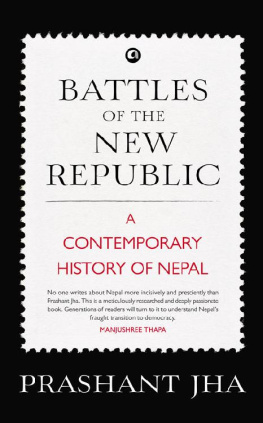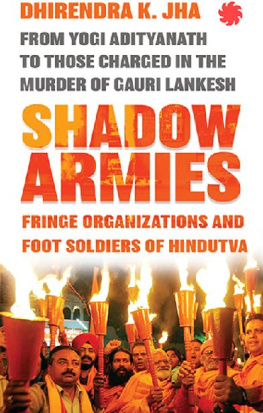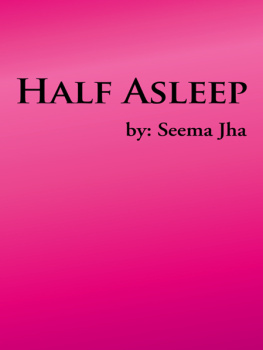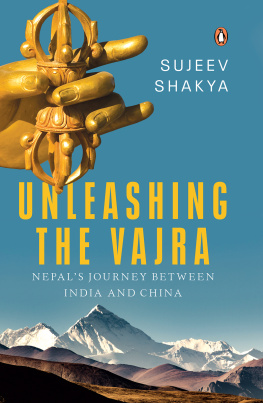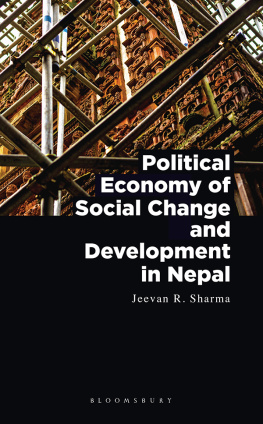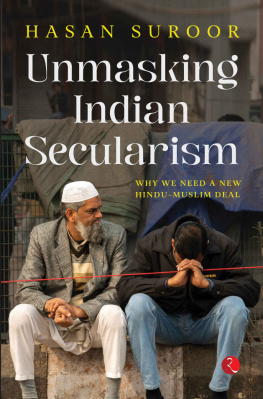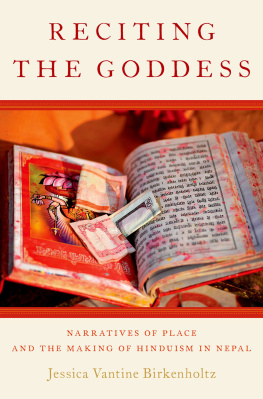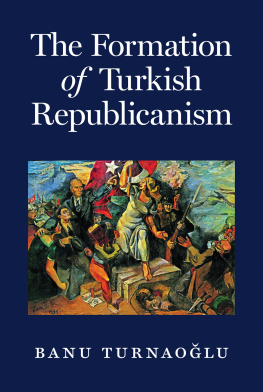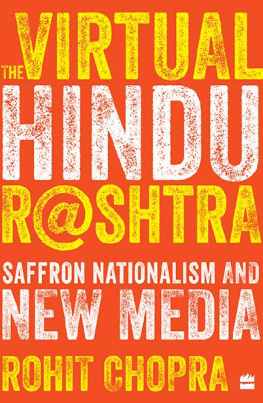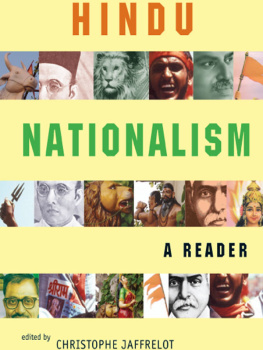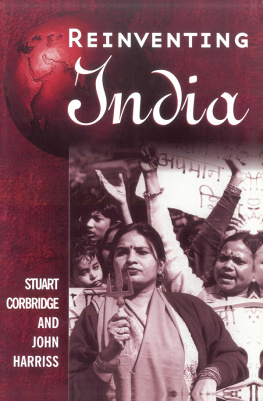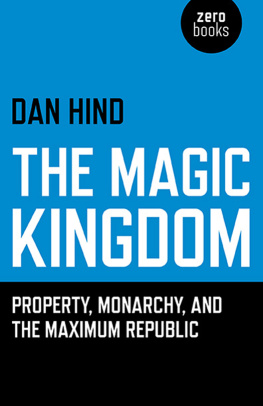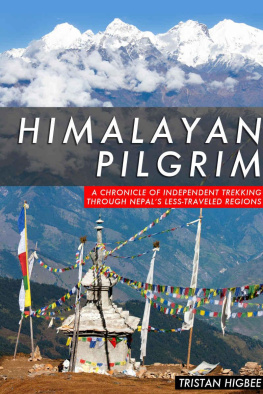BATTLES
OF THE
NEW
REPUBLIC
A
CONTEMPORARY
HISTORY OF NEPAL
PRASHANT JHA
ALEPH BOOK COMPANY
An independent publishing firm
promoted by Rupa Publications India
First published in India in 2014 by
Aleph Book Company
7/16 Ansari Road, Daryaganj
New Delhi 110 002
Copyright Prashant Jha 2014
All rights reserved.
No part of this publication may be reproduced, transmitted, or stored in a retrieval system, in any form or by any means, without permission in writing from Aleph Book Company.
eISBN: 9789383064540
This book is sold subject to the condition that it shall not, by way of trade or otherwise, be lent, resold, hired out, or otherwise circulated without the publishers prior consent in any form of binding or cover other than that in which it is published.
To Tatta,
for making the journey;
to Papa,
for fighting it out, being so brave;
and to Mummy,
for being the pillar, and for holding us together
Contents
List of Illustrations
A Timeline of the Transition
1951: The year marks the end of the 104-year-old, autocratic Rana oligarchy. King Tribhuvan Shah, the Nepali Congress (NC) and Rana rulers arrive at a compromise in Delhi, mediated by Jawaharlal Nehru, and agree to hold elections for a Constituent Assembly (CA).
1959: Parliamentary elections are held under a Constitution granted by King Mahendra Shah. The NC wins two-thirds majority.
15 December 1960: Mahendra Shah dismisses Nepals first democratically elected government, headed by Prime Minister Bishweshwor Prasad Koirala.
1962: The monarch promulgates a Constitution which institutionalizes a party-less framework and centralizes power in the Palace. This is known as the Panchayat system.
1972: Mahendra Shah dies at fifty-two and Birendra Shah takes over as the new king.
1979-80: Student protests force the king to call a referendum on the nature of the polity. The party-less framework defeats the multiparty system amid suspicions of electoral fraud.
1990: A Peoples Movement, the Janandolan, leads to the restoration of multiparty democracy. A new Constitution limits the monarchys role, retains Nepal as a Hindu kingdom, paves the way for a parliamentary system, and grants fundamental rights. Radical Left forces reject the Constitution.
1991: Elections are held. The NC wins and Girija Prasad Koirala is elected prime minister.
1994: An internal rift in the NC leads to mid-term polls; the Communist Party of Nepal (Unified Marxist Leninist) [UML] emerges as the single largest party. Veteran Left leader Manmohan Adhikari becomes prime minister.
1995: NC leader Sher Bahadur Deuba becomes prime minister with the support of a pro-monarchy outfit, the Rastriya Prajatantra Party.
1996: The Communist Party of Nepal (Maoist) launches a Peoples War.
1996-99: Nepals run with instability continues, with three different prime ministers in as many years. The third parliamentary poll results in a victory for the NC. Krishna Prasad Bhattarai is elected prime minister.
2000: Prime Minister Bhattarai initiates back-channel talks with the Maoists, but is replaced by G. P. Koirala, who advocates a more belligerent, security-based approach.
2001
June: King Birendra and his immediate family are massacred. The official investigation indicts Crown Prince Dipendra, amid widespread perception of a conspiracy. Birendras younger brother, Gyanendra, takes over as monarch.
July-November: Ceasefire talks are held between the government, now led by Sher Bahadur Deuba, and the Maoists.
23 November: The Maoists attack a barracks of the Royal Nepalese Army (RNA). The ceasefire collapses, the government declares an emergency and deploys the RNA. The civil war intensifies.
2002
May: As NC president, G. P. Koirala, opposes the extension of the emergency, Prime Minister Deuba dissolves Parliament with the support of the Palace and the RNA. The NC splits.
4 October: King Gyanendra dismisses Prime Minister Deuba, assumes a more direct political role, and appoints a loyalist, Lokendra Bahadur Chand, as prime minister.
2003
February: A second ceasefire is signed between the Nepal government and the Maoists.
August: The RNA executes seventeen unarmed Maoists in Doramba. The civil war resumes.
2005
1 February: King Gyanendra assumes direct executive power, arrests political leaders, stifles civil liberties and declares a state of emergency.
October: A Maoist party conclave in Chunbang declares that the partys immediate political objective is to make Nepal a democratic republic; monarchy and feudalism are categorized as the principal enemies.
22 November: A 12-point Understanding is signed between the Seven Party Alliance and the Maoists in Delhi to fight autocratic monarchy.
2006
April: A nineteen-day Peoples Movement, the second Janandolan, succeeds. King Gyanendra concedes that sovereignty rests with the people. The Parliament, dissolved in 2002, is reinstated. A ceasefire is declared and G. P. Koirala takes oath as prime minister.
May: The Parliament clips royal privileges, brings the RNA under direct civilian rule, declares Nepal a secular state and abolishes untouchability.
16 June: Maoist chairman Prachanda appears over ground, escorted by Nepals home minister, Krishna Prasad Sitaula. Peace talks begin at Prime Minister Koiralas residence.
21 November: The Comprehensive Peace Agreement declares the end of the civil war and creates a roadmap for elections to a CA.
2007
15 January: An interim Parliament is constituted with participation by the Maoists. An interim Constitution is also promulgated, which replaces the Constitution of 1990.
16 January:Upendra Yadav of the Madhesi Janadhikar Forum is arrested in Kathmandu after he sets fire to a copy of the interim Constitution.
17 January: A young protestor, Ramesh Mahato, is killed in Lahan. The Madhes movement erupts across Nepals southern plains.
7 February: Prime Minister Koirala promises federalism and an equitable electoral system.
1 April: An interim government, with ministers from the Maoist party, is constituted.
December: Parties agree to institutionalize a mixed electoral system and to abolish the monarchy by the time the CA holds its first meeting.
2008
February: The Second Madhes movement breaks out. An 8-point agreement, hammered out between the government and Madhesi parties, commits to a Madhes province, the group entry of Madhesis into the Nepal Army (NA), and to ensuring the proportionate and inclusive representation of Madhesis in organs of the state.
March: Free Tibet protests erupt in Kathmandu. China asks the Nepal government to crack down on the protesters.
10 April: Elections are held. In a surprise result, the Maoists emerge as the single-largest party.
28 May: The CA holds its first sitting. The monarchy is abolished and it is decided that Nepal will have a Federal Democratic Republican Constitution.

